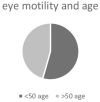Alteration Ocular Motility in Retinitis Pigmentosa: Case-Control Study
- PMID: 38410094
- PMCID: PMC10895995
- DOI: 10.2147/OPTO.S446717
Alteration Ocular Motility in Retinitis Pigmentosa: Case-Control Study
Abstract
Purpose: To evaluate ocular motility (OM) disorders and strabismus in a sample of patients with retinitis pigmentosa (RP) and a control sample.
Methods: In this cross-sectional retrospective analysis, we studied a sample of RP patients with a mean age of 48.74 years and an average visual acuity of 7/10 based on Snellen optotype and a sample of control patients with similar mean age (49 years [men], 47 years [women]) and sex and an average visual acuity of 9.9/10, with the aim of assessing correlations between alteration of OM and strabismus in RP patients based on age, high refractive defect, or severely impaired binocular vision. The examination followed a protocol of testing for anamnesis and best-corrected visual acuity, as well as a complete eye examination, corneal reflex, cover test, OM, Hess screen, and Lang test.
Results: At the first orthoptic evaluation, 45.16% of patients showed strabismus, 41.93% exotropia (25% of cases intermittent), 3.22% esotropia, and 6.45% vertical deviation. Later evaluation showed strabismus in 25.80% of patients, exotropia in 19.35% (9.67% intermittent), esotropia in 3.22%, and vertical deviation in 3.22%. Assessment of eye motility study showed 51.6% overaction of the inferior oblique and hypofunction of the superior rectus, and 18% overaction of the lateral rectus and hypofunction of the medial rectus. According to our results, alterations in OM and strabismus in RP patients are not correlated with age or high refractive defect. Therefore, motility disorders and strabismus are attributed to a genetic factor to which men are more susceptible.
Conclusion: The incidence of OM disorder was 77.42%, and strabismus was present in 45.16% of patients.
Keywords: genetic factor; ocular motility; orthoptic evaluation; retinitis pigmentosa; strabismus.
© 2024 Comberiati et al.
Conflict of interest statement
The authors report no conflicts of interest in this work.
Figures










Similar articles
-
Eye Motility Alterations in Retinitis Pigmentosa.J Ophthalmol. 2015;2015:145468. doi: 10.1155/2015/145468. Epub 2015 Jun 1. J Ophthalmol. 2015. PMID: 26124957 Free PMC article.
-
Management of strabismus in nanophthalmic patients: a long-term follow-up report.Ophthalmology. 2003 Jun;110(6):1230-6. doi: 10.1016/S0161-6420(03)00267-7. Ophthalmology. 2003. PMID: 12799252
-
[Strabismus Sursoabductorius (put into the Context of eighteen Years of Strabismus Surgery Analysis)].Cesk Slov Oftalmol. 2015 Winter;71(6):267-76. Cesk Slov Oftalmol. 2015. PMID: 26782915 Czech.
-
[Unilateral combined strabismus surgery to correct esotropia : Video article on recession of the medial rectus muscle and plication of the lateral rectus muscle].Ophthalmologe. 2018 Nov;115(11):961-966. doi: 10.1007/s00347-018-0784-z. Ophthalmologe. 2018. PMID: 30194471 Review. German.
-
Predictors of stereoacuity outcome in visually mature subjects with exotropia.Eye (Lond). 2016 Feb;30(2):264-9. doi: 10.1038/eye.2015.241. Epub 2015 Nov 20. Eye (Lond). 2016. PMID: 26584792 Free PMC article. Review.
References
-
- O’Neal TB, Luther EE. Retinitis Pigmentosa. In: StatPearls. StatPearls; 2018. - PubMed
LinkOut - more resources
Full Text Sources

